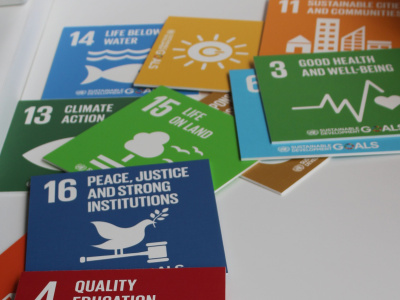
The Sustainable Development Goals, the EU and member states: Getting their act together and acting together
Back in 2015, the European Union took a serious commitment to reach a number of ambitious, transformative and universal Sustainable Development Goals (SDGs) by 2030. However, the gap between commitments and the piecemeal approach to putting them into action is widening. While the EU was undeniably a driving force in the run-up to the 2030 Agenda, it still lacks a proper strategy to implement the SDGs at EU level in a comprehensive and integrated manner that brings together the external and internal dimension.
Looking ahead to the long-term implementation of the SDGs, the Commission has announced a reflection paper on the follow-up to the SDGs and the Paris Agreement, due in the second quarter of 2018 – almost three years after the adoption of the SDGs.
The 2030 Agenda should be an opportunity for the EU not only to strengthen its role as a global player committed to effective multilateralism but also to lead by example, making the SDGs part and parcel of the EU’s long-term objectives and the future of Europe. In these changing political times, implementing effectively the SDG agenda is no less relevant and indeed may provide some common direction.
The clock is ticking, expectations are high
The initial response of the Commission to the 2030 Agenda came late, was incomplete and did not live up to these expectations. No major overhaul of EU policies was proposed to support it as the Commission was primarily committed to delivering on the ten political priorities set by president Juncker for the period 2015-2019. The Commission argued that all SDGs are already integrated in current EU priorities, policies, funds and other actions. It conceded that the SDGs would need to be further mainstreamed in current and future policies, but there again, this was to happen essentially by making use of existing tools and coherence mechanisms (including the ‘better regulation’ toolbox).
Although they came in quite late, the Conclusions of the Council representing the EU member states adopted in June last year were somewhat less complacent. The document recognised that a higher level of ambition is required from both the EU institutions and the member states to implement the 2030 Agenda. Member states urged the Commission to undertake a comprehensive gap analysis, identify further action in all relevant policy areas, and to speed up the elaboration of an EU-wide SDG implementation strategy with timelines, objectives and concrete measures.
The Council also acknowledged that the universal and integrated nature of the 2030 Agenda and the interlinkages between SDGs call for a much more holistic and coherent approach that involves internal and external actors. This required some structural reorganisation of the Council’s own working methods. In particular, all relevant Council formations and their working groups should ensure the coherence of sectoral policies and include all three dimensions of sustainable development – economic, social and environmental – in EU internal and external policies. This seemingly technical evolution in working formations is a strong statement of intent and a different way of doing business.
Thematic policy areas to fully embrace the 2030 Agenda
Up until now, Council discussions on post-2015 and on the SDGs have been confined to the external affairs community (essentially three different working parties respectively on development cooperation, global environment and UN affairs) under the patronage of EU ministers of foreign affairs and/or development.
The creation in November 2017 of a dedicated Council working party on the 2030 Agenda is an important step towards breaking down the silos among policy sectors. The objective is not only to de-compartmentalise the SDGs and raise the awareness, involvement and ownership of all other relevant policy areas and ministries but, more importantly, to increase consistency and synergies between internal and external policies through horizontal and cross-sectoral approaches.
This leap towards greater policy coherence and integration needs further nurturing and leadership by member states. It also requires the Commission to step up its game by bringing actors and policy sectors together.
Three steps to achieving the SDGs inside and outside the EU
One: learn from each other on how to promote innovative integrated policy approaches for sustainable development. The newly established multi-stakeholder platform on SDGs is an opportunity to bring in views and ideas from a wider public to support the implementation of SDGs at EU level. How these views will be taken into account in the design and monitoring of sustainable development policies remains to be seen.
Two: use the upcoming negotiations on the next Multiannual Financial Framework as an opportunity to reshape the EU’s internal and external financial instruments for the implementation of the 2030 Agenda. Tough arguments are expected between budget headings, but the only options being floated until now concern heading 4, such as the merging of the European Development Fund and the Development Cooperation Instrument, and the creation of a single instrument for sustainable development cooperation. Going further, there is the need to think whether the SDGs could be mainstreamed throughout the entire budget and instruments in all EU budget headings.
Three: move beyond the rhetoric on policy coherence to put it to the test in specific areas. The concept of Policy Coherence for Sustainable Development evoked in SDG 17 – and in the very wording of many of the other Goals – suggests that everything should be integrated with everything else. Yet that can easily be a recipe for achieving nothing. A more productive way forward is probably to identify the key factors that need to be taken into account in any particular policy nexus and seek to ensure these are well catered for and balanced out. The experience of promoting Policy Coherence for Development shows that progress can be made on policy coherence if a clear objective is set.
At a time when the EU and its member states are facing major internal and external challenges of an existential nature, the 2030 Agenda offers a unique and collectively agreed framework in which to embed the future of Europe. By putting in place clear policies and effective and different collaborative working methods for its own plans on the SDGs, the EU could show real leadership on sustainable development.
The views expressed are those of the author and not necessarily those of ECDPM.




